Japanese
Enlistment Banners
When men left for their military
service, community organizations such as the local branch of the Imperial
Reservists Association (teikoku zaigo
gunjinkai) and the Greater Japan National Defense Women’s Association (dai nippon kokubo fujinkai) organized
various celebrations, culminating in send-off parades to wish the troops well
as they marched off to the local railway stations. The participants carried
banners with the names of the recruits. Nakata’s well-known book Imperial Japanese Army and Navy Uniforms and
Equipments [sic] has pictures of such banners on page 220. He calls them
“celebration banners” in English. The Japanese term for banner is nobori. They came in a wide variety of
sizes, including some that were huge. I am not sure whether these banners are
made of silk or an early synthetic like rayon. I suspect they may be silk,
because they all have numerous small holes that look like they were made by
insects, and I don’t think insects eat rayon. However, I am no expert on
textiles, so I am hoping to clarify this by showing mybanners to someone who
does know cloth.
Here are a couple of pictures of
crowds carrying these banners. The first one comes from Mainichi Gurafu, Special Issue 1-1, 1975, Ichi oku nin no Showa goju nen shi (50
years of Showa history for 100 million people), p. 67. The photo is dated
Decmber, 1938 and shows troops being called up for the war in

This one is credited to the Mainichi Shimbun, December, 1938, and
shows a send-off parade for troops of the Third Regiment. The building seen in
the upper right corner of both photos looks the same, so they may be photos of
the same crowd. A reference book I have says the Third Regiment was based in
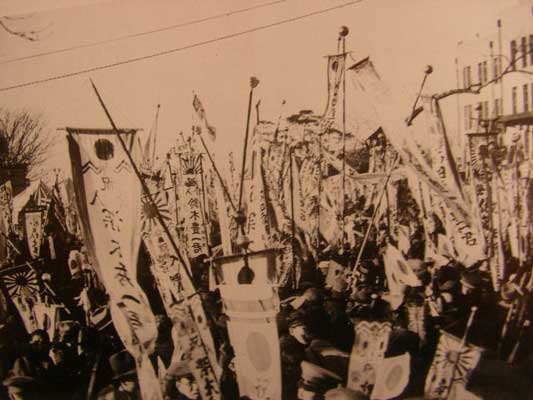
There is also rare colour movie
footage of such a send-off parade in the documentary “
The first banner I acquired myself is
medium-sized, about 57” high (145cm), including a 1.75” (4cm) fringe at the
bottom, and 16.5” (42cm) wide. It seems to be made of a coarse silk. These
banners were carried suspended from a vertical pole (see some below that still
have the hanger attachment). Below the two crossed flags is a blue-green
character shuku, or “celebrate”, then
two orange ones read right to left: nyu-ei,
“entering the [military] service”. Below that is a central column of black
hand-written characters: O-hashi
Yoshi-kazu-kun, “Mr. Yoshikazu Ohashi”. The characters in smaller columns
to the right and left are hard to read since the ink bled when applied. The
column on the right says ho-ken-in-kan-i-ho-ken-kyoku,
meaning “Insurance Institution, Postal Insurance Office” (the post office in
Japan even today is also a financial institution which accepts savings deposits
and sells insurance). The left column continues: dai-ni-shi-harai-ka-kan-pu-kin-gakari, or “Number 2 payments
section, clerk in charge of reimbursement” . There are
a number of holes in this banner. Oddly, they almost all seem to be in areas
that are blue-green, which makes me wonder whether that colour dye was either
corrosive to cloth or tasty to bugs.

This one is made of several pieces
of material sewn together and gives the impression of higher quality. The red
character just below the flags is shuku,
“congratulations”. The two black characters below that are osho, “drafted”. Combined they mean “congratulations on being
called up”. Below that is the man’s name, Mr. Hiroyoshi Kawamura. In the lower
left the smaller column of characters says yama-moto-ji-ten-sha-ten,
“Yamamoto Bicycle Shop”. Presumably this was his pre-call-up employer.
Including the fringe at the bottom, this banner is about 53” by 17” (135cm X
44cm).
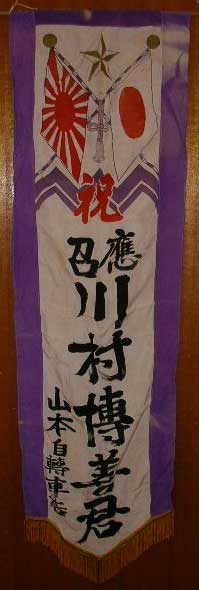
I was quite excite
to get this third one, for two reasons. First, it was the first one I got that
had the original hanging rod and hardware (see close-up below). The other thing
was a surprise I only discovered when I translated it. The character at the top
in the centre of the rising sun rayed flag is the usual shuku, “congratulations”. The soldier’s name down the centre is Mr.
Toshimasa Kurita. The family name Kurita means “chestnut field”. All of that,
of course, is quite standard.

This close-up of the lower left part
shows the surprise. This is where they wrote the donor of the flag, which was
usually the soldier’s normal employer. The first character means “gift of”. Then
the name of the business: Tachibana Billiard Hall!

Here is a close-up of the hanger
hardware. The tassle is affixed with an eye screwed into the wood through a
hole in the metal covering. The hanger cord was originally affixed the same
way, but here I had to just jam it into the metal covering sideways since the
eyes had been snapped off on both sides.
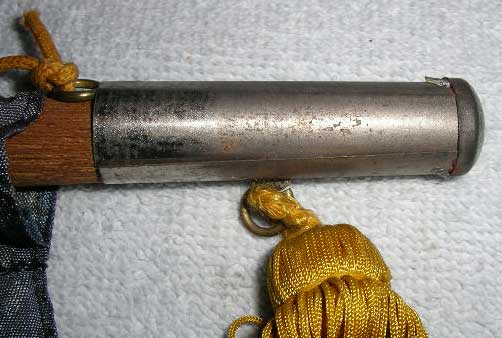
This is a very small banner: just 8”
by 33” (20cm by 84cm). It has the original hanging hardware as well (see
close-up below).

A closer view shows large charaters
in the centre with the soldier’s name, Mr. Shunji Noguchi and smaller ones to
the left identifying the donor, Nippon
Tosha Geijutsuin (

The hanger cord for this one has a ball on a
stick. It seems this was intended to drop into the hollow centre of a piece of
bamboo to make a carrying pole.
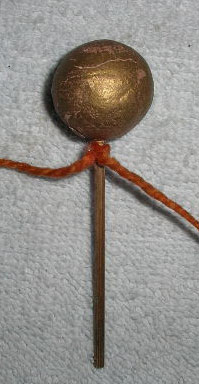
Here we can see the hanging cord attachment,
which is very simple: the cord is just tied around the bar, which is a thin
piece of bamboo painted black.

This one is quite large and
luxurious. The size is 17.5” by 70”, or 44cm by 178cm. It is made of different
pieces of cloth sewn together. The red characters under the two crossed flags
are read from right to left: shussei, meaning “being sent to the front” or
“called to active service”. The large black characters in the centre say shuku (celebration) and then the
soldier’s name, Mr. Isamu Ishikawa.

The characters on the right and left are his
employer: Nip-pon Sei-mei (Japan Life
Insurance, a company that still exists under basically the same name) on the
right, O-no-ji-mu-sho, Ono Office, on
the left. The red symbol in the upper right of this photo is the company logo.
The character in the middle of the logo is sei,
life, the first character in sei-mei-ho-ken,
life insurance.

Here is a close-up of the hanger bar
and how the cord attaches to it, showing yet another method. On this one there
is a hole drilled straight through the bar and the cord is threaded through the
hole and knotted on the bottom. Note the fine paper covering on the bamboo bar.

One thing that gives this banner a
particularly luxurious look is the brocaded texture of the green material.
Obviously Nippon Seimei could afford to look after its employees well!
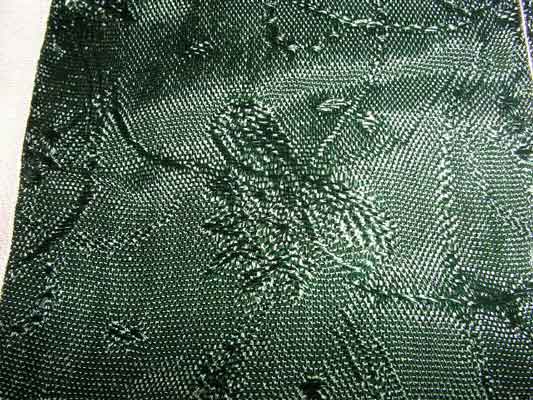
This one is even larger: 24” wide
and 72” long (64cm X 180cm). The blue character at the top is the ubiquitous shuku (celebration). The two black ones
below the zig-zag line (an Army symbol that I think represents
mountains) are shussei, being
called to the front or to active service. The man’s name down the centre is Mr.
Ueki Masataka.

The gold-coloured bird at the top is
probably an allusion to the golden kite (a bird of prey) that supposedly appeared
to the mythical first emperor, Emperor Jimmu, and ensured his victory over his
enemies by advising him to attack at dawn from the east so they would be
blinded by the sun. The Order of the Golden Kite was
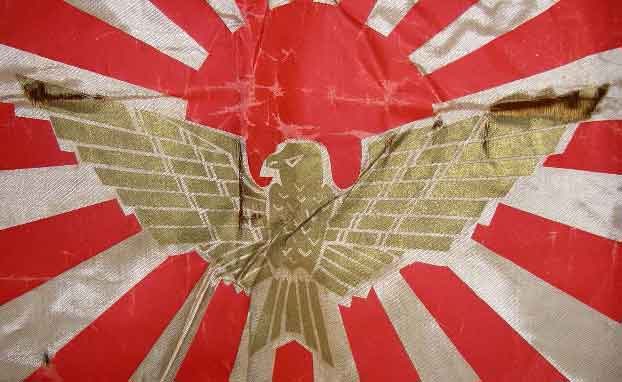
Here is a close-up of the man’s
employer, Abeko shoten,

Last updated: November 17, 2004. All contents are copyright Teri unless otherwise specified and may not
be used elsewhere in any form without prior permission.
Click here to go back to the Other Militaria
page: Teri's Japanese
Handgun Website: Other Japanese Militaria
Click here to go back to the main page: Teri’s Japanese Handgun Website